
The Next Trillion Dollar Wave - AI Narrative in Crypto: Who Are the Top Players?
Dec 12, 2024 21:40
Written by TechFlow
Introduction
State channels (Lightning Network), sidechains (Stacks), rollups (BitVM), UTXO + client validation (RGB++ Layer)—which will emerge as the solution that unites the Bitcoin ecosystem, enabling scalability, interoperability, and programmability while introducing innovative narratives and significant growth?
Infrastructure oversupply has become a significant issue this cycle—when supply outstrips demand, new blockchains and L2s go all out to prevent themselves from turning into ghost towns. However, in the Bitcoin ecosystem, a different narrative is unfolding.
Since the rise of the “Inscriptions Craze,” the market has seen the community’s enthusiasm for participating in the Bitcoin ecosystem. However, before the ecosystem truly explodes, Bitcoin requires a robust infrastructure to overcome scalability limitations. Large institutional investments, often in the tens of millions, are further driving this infrastructure build-out, with Bitcoin’s “city” bustling with construction and growth this cycle.
Everyone seems keen to grab a slice of the Bitcoin ecosystem, but it’s not as straightforward as it appears.
Why is that?
Expanding Bitcoin is no easy task, given its non-Turing completeness and other limitations. Each project follows its journey, and the quest for Bitcoin scalability is still in a state of tumultuous exploration.
During this process, we witness the resurgence of traditional scalability solutions like the Lightning Network, known for its “legitimacy,” and the wild growth of more innovative narratives, such as CKB’s extension of RGB into RGB++ . At the same time, sidechains and L2 solutions are in fierce competition, with some directly borrowing from Ethereum’s strategies while others deeply explore Bitcoin’s unique characteristics to propose enhanced solutions.
With the trillion-dollar market potential of the Bitcoin ecosystem and the myriad technical paths to achieve it, which scalability protocols will stand out? Which will unite the Bitcoin ecosystem, enabling true scalability, interoperability, and programmability, while bringing innovative narratives and significant growth?
This article aims to dive into Bitcoin’s scalability protocols, offering a comparative analysis of the strengths and weaknesses of the major solutions and examining the future trends of Bitcoin scalability.
Following the logic of “first establishing its necessity, then explaining why ,” let’s first discuss: is Bitcoin scalability a false need?
The answer is clear—it’s not only a real need, but Bitcoin arguably requires scalability solutions more than any other blockchain.
This argument is supported by various real-world factors.
On the market level, whether it’s the craze around Inscriptions or the millions in institutional investments, we can clearly see the market’s enthusiasm for the Bitcoin ecosystem. This enthusiasm is understandable—over the past few years, many Bitcoin holders have been eager to do more than just “Hold.” The absence of meaningful opportunities for engagement in the ecosystem has been frustrating, so when new narratives emerge within Bitcoin, holders are keen to participate.
From Bitcoin’s perspective, as the pioneer and founding figure of the crypto space, Bitcoin has evolved over more than a decade. The interests of participants within the ecosystem are intricately interwoven, and any movement impacts the whole network. Maintaining a balance while retaining long-term appeal is a critical challenge. With the 2024 halving reducing block rewards, miners’ profitability will decrease, pushing Bitcoin to explore ecosystem growth and richer value flows. Bitcoin needs its ecosystem to empower all participants and attract new users.
More importantly, Bitcoin holds several advantages for ecosystem development that no other blockchain can rival. Bitcoin’s growth is driven by its community and has stood the test of over ten years of stable operation. With a market cap of $1.2 trillion, it enjoys unparalleled recognition and trust among the global public and investors. This gives Bitcoin an unmatched degree of decentralization and a robust security foundation. Moreover, due to the previous lack of ecosystem development, vast amounts of Bitcoin capital have remained dormant, with limited avenues for value creation. This has only fueled confidence in the explosive potential of the Bitcoin ecosystem.
However, Bitcoin’s inherent design limitations significantly hinder its ecosystem’s growth. As is well-known, Bitcoin can process only 3–7 transactions per second, and during peak periods, network congestion is common. Users often have to pay higher fees for faster transaction confirmation, leading to slow speeds, high costs, and long confirmation times. More importantly, Bitcoin’s non-Turing completeness limits its ability to execute complex logic, deterring developers from building sophisticated smart contracts on the network.
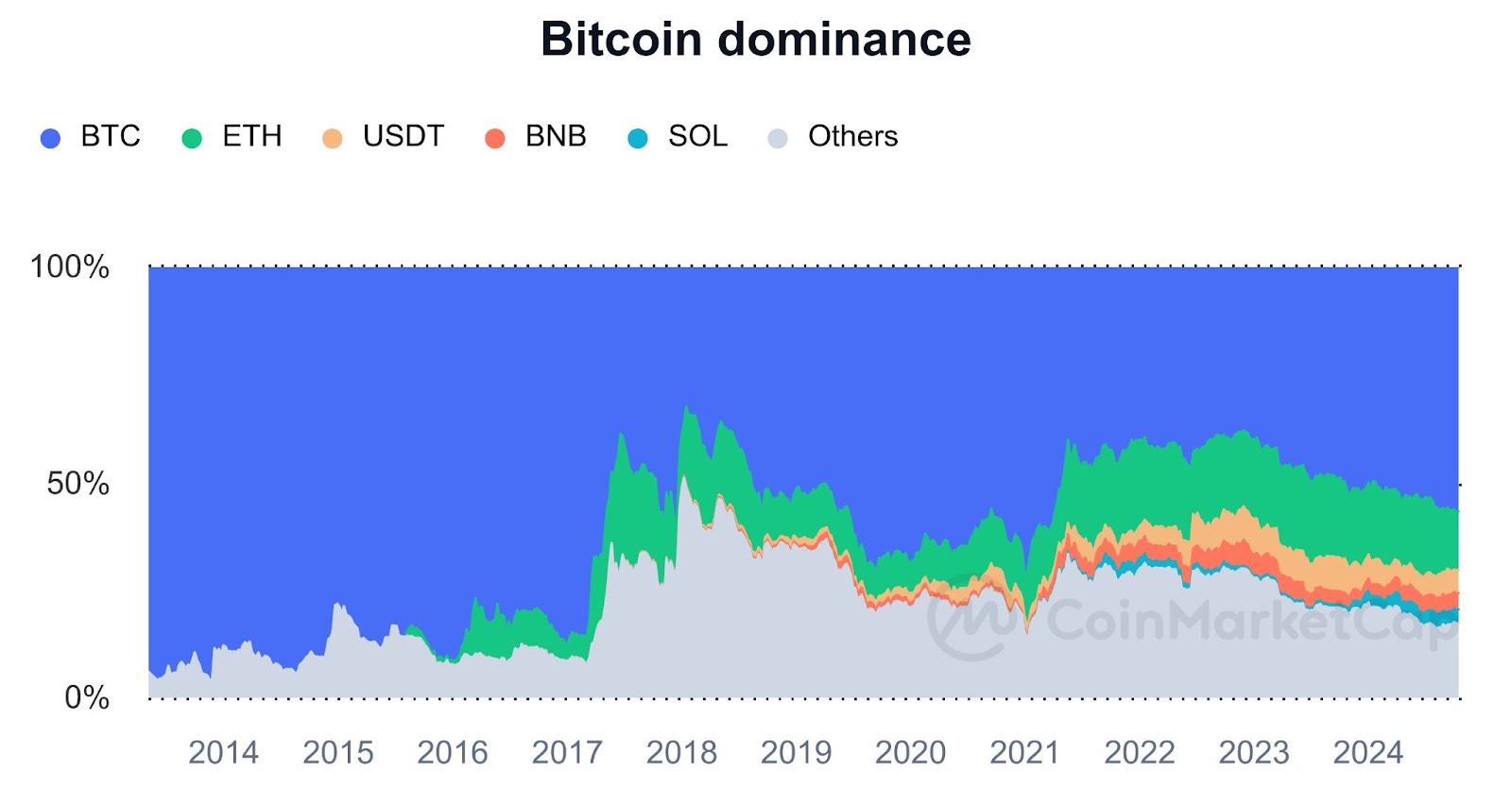
Faced with a Bitcoin ecosystem that is powerful and highly anticipated by the market but hindered by inherent limitations, scalability has become the essential path for Bitcoin’s explosive growth. In an era where discussions focus more on demand than on technology, Bitcoin’s scalability solutions are being developed by working backward from these demands, carefully balancing what should change and what should remain constant.
Bitcoin scalability protocols aim to address several key challenges stemming from Bitcoin’s own limitations:
One of the core goals of Bitcoin scalability protocols is to enhance the user transaction experience, focusing on improving efficiency and reducing costs.
In addition, these protocols aim to help Bitcoin achieve Turing-complete smart contract functionality, allowing developers to build complex logic-based applications within the Bitcoin ecosystem. This development would expand Bitcoin’s utility beyond simple value transfers, enabling it to support more diverse financial products and services, such as decentralized finance (DeFi) applications and automated contract execution. This will greatly enrich Bitcoin’s use cases and attract more developers and users.
Another significant change these protocols aim to bring is improved interoperability between Bitcoin and other blockchains and ecosystems. By breaking down the existing isolation, enabling integration and cooperation across different platforms, users will be able to transfer assets and data more easily across chains. This interoperability will strengthen connections within the broader blockchain ecosystem, fostering resource sharing and collaboration, and driving innovation and development.
However, in recognizing Bitcoin’s strengths, scalability protocols are also dedicated to preserving and enhancing certain aspects:
Bitcoin scalability protocols aim to inherit and uphold Bitcoin’s decentralization and strong security. This not only guarantees higher security standards but also brings true innovation to the Bitcoin ecosystem, as opposed to simply creating a bridge to inject Bitcoin assets into other ecosystems to benefit them.
Another key point is that Bitcoin scalability protocols should aim to expand without altering the main network as much as possible. Historically, Bitcoin has attempted various on-chain scalability solutions and upgrades, such as increasing block size and Segregated Witness (Segwit), which have laid a solid foundation for future scalability. However, since most on-chain scaling solutions involve changes to the main network code and often sacrifice some degree of decentralization and security, these solutions are approached with caution. The community is now more inclined toward off-chain solutions built on top of Bitcoin Layer 1, which address performance issues without affecting Bitcoin’s base layer.
With this understanding of what should change and what should stay constant, we can now establish specific evaluation criteria for Bitcoin scalability protocols. By comparing the mainstream scalability solutions currently available in the market against these criteria, readers will gain a clearer understanding of the pros and cons of various technical approaches.
Based on different technical implementation paths, the mainstream Bitcoin scalability solutions in the market today can be categorized into the following types:
State Channels
Sidechains
Rollups
UTXO + Client Validation
State channels are one of the earliest and most legitimate attempts at scaling Bitcoin, with the most well-known project being the Lightning Network.
By definition, a state channel establishes a channel between two or more parties, allowing them to conduct multiple transactions within the channel. Only the final state is recorded on the Bitcoin main chain, improving speed and reducing costs.
We can explain the working principle of state channels with a vivid example:
Imagine a group of people pooling some funds to create a WeChat Pay group. Within this group, transactions occur quickly and at low fees. Once the group disbands, all payment states that occurred within the group are confirmed and updated on the Bitcoin main chain.
From this explanation, the pros and cons of state channels become clear:
The advantages include significantly reducing the computational load on the main network, thereby lowering transaction fees and increasing transaction efficiency. Since the Bitcoin main network validates the final state, state channels inherit Bitcoin’s strong security. Additionally, because multiple transactions can occur within the channel, state channels theoretically enable infinite TPS (transactions per second).
However, there are also notable drawbacks. Setting up a channel has high technical and cost barriers, and users can only transact with others within the channel, leading to significant limitations. Furthermore, state channels require funds to be locked up in advance, impacting liquidity. Most importantly, state channels do not support smart contracts, which is a crucial feature for the Bitcoin ecosystem moving forward.

Source: Internet
The concept of sidechains has been around for quite some time. Essentially, a sidechain is an independent chain that runs parallel to the main chain. It allows users to transfer assets from the main chain to the sidechain for interaction, with the two connected through a two-way peg mechanism.
There are quite a few projects that have adopted this technical approach. In addition to the well-known veteran project Stacks, the rising newcomer Fractal Bitcoin has recently garnered attention from the community.
Since sidechains operate independently from the Bitcoin mainnet, they theoretically have the potential to break free from the technical limitations of Bitcoin’s framework, enabling the adoption of more advanced designs for better performance and user experience.
However, this independence also means that sidechains cannot fully inherit Bitcoin’s strong security foundation. Instead, their security is based on their own consensus mechanisms, which can present significant centralization issues, particularly in the early stages of operation. That said, many sidechain projects are working on innovative solutions to address these challenges, focusing on enhancing their consensus mechanisms to better align with Bitcoin’s security infrastructure.
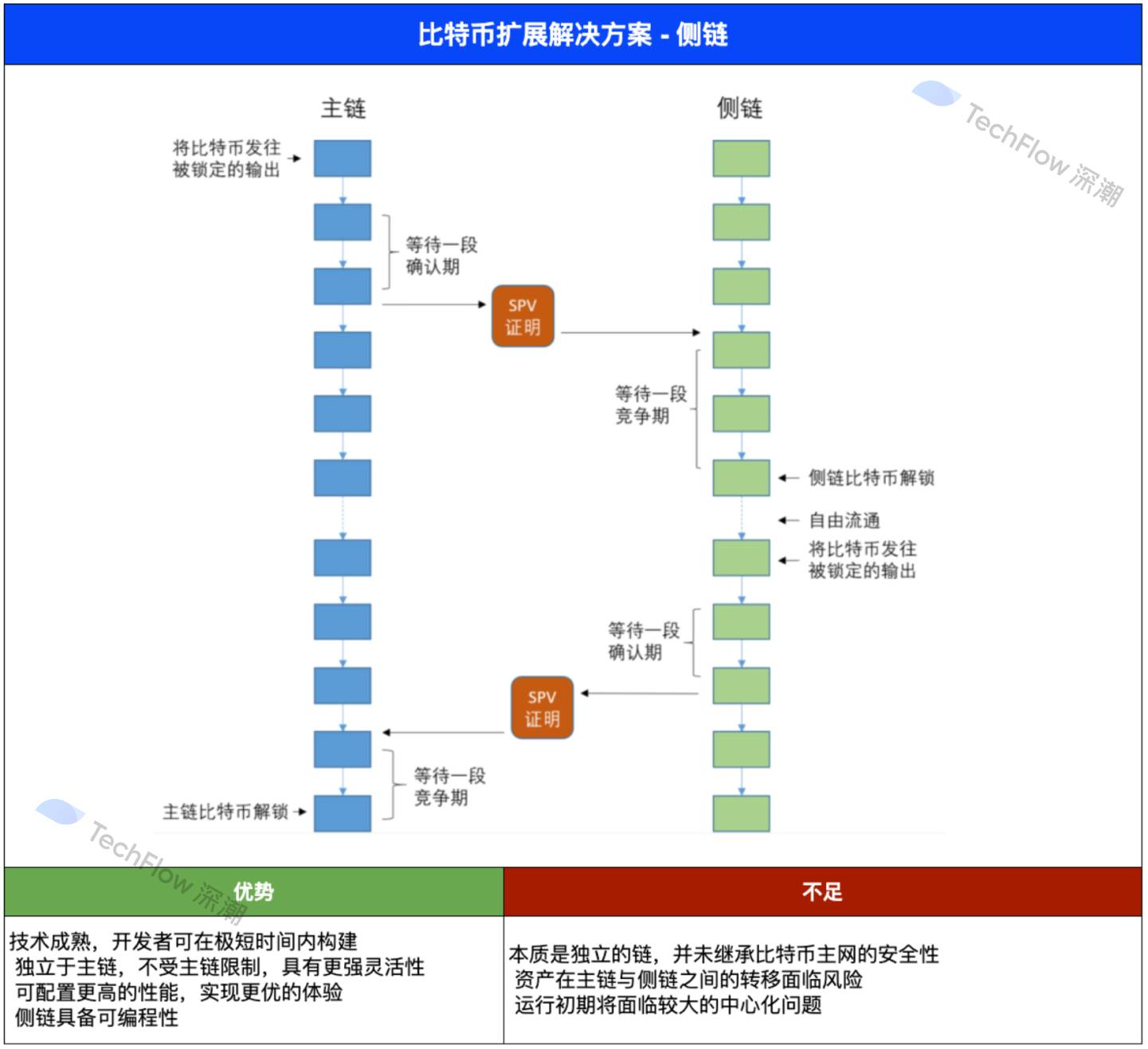
Source: Internet
Many people are familiar with Rollups primarily through Ethereum’s Layer 2 solutions. In Ethereum’s highly competitive Layer 2 space, Rollup projects have emerged in great numbers, dominating the landscape. Similarly, in the current wave of Bitcoin infrastructure development, the Rollup approach is also gaining prominence within the Bitcoin ecosystem. Notable projects such as B² Network and Bitlayer have already become popular within the Bitcoin community.
In terms of operational logic, Rollups execute transactions off-chain and then bundle multiple transactions together, submitting them to the main chain in batches. This approach ensures data availability on the main chain, inheriting the security and decentralization of the main chain while significantly reducing the amount of data that needs to be stored on-chain. This could potentially alleviate congestion on the Bitcoin network and lower transaction costs.
However, unlike Ethereum, which has a virtual machine that allows most Ethereum Rollups to use Ethereum’s blockchain for data availability and consensus, Bitcoin lacks such a virtual machine. This raises the question: how can Bitcoin Layer 1 verify the validity of Rollup proofs? This poses additional challenges for Bitcoin scalability projects choosing the Rollup path.
Currently, there are three main types of Rollups in the Bitcoin ecosystem, but none of them are flawless:
Optimistic Rollups (OP Rollups) operate based on a trust assumption, where transactions are assumed valid by default but are subject to a challenge period. This model is simpler and easier to integrate, allowing for greater scalability. However, the dispute window introduces delays in transaction finality.
Sovereign Rollups take a more independent approach, storing data availability on the main chain but validating and executing transactions via their own consensus mechanism. This model allows Rollups to share Bitcoin’s security foundation while avoiding the limitations of Bitcoin’s script, though it imposes stringent requirements on the Rollup’s consensus mechanism itself.
Validity Rollups (including ZK Rollups) use cryptographic proofs to verify the correctness of off-chain transaction batches without revealing the underlying data. This method balances efficiency and security, though the complexity and computational demands of generating ZK proofs remain a significant challenge.
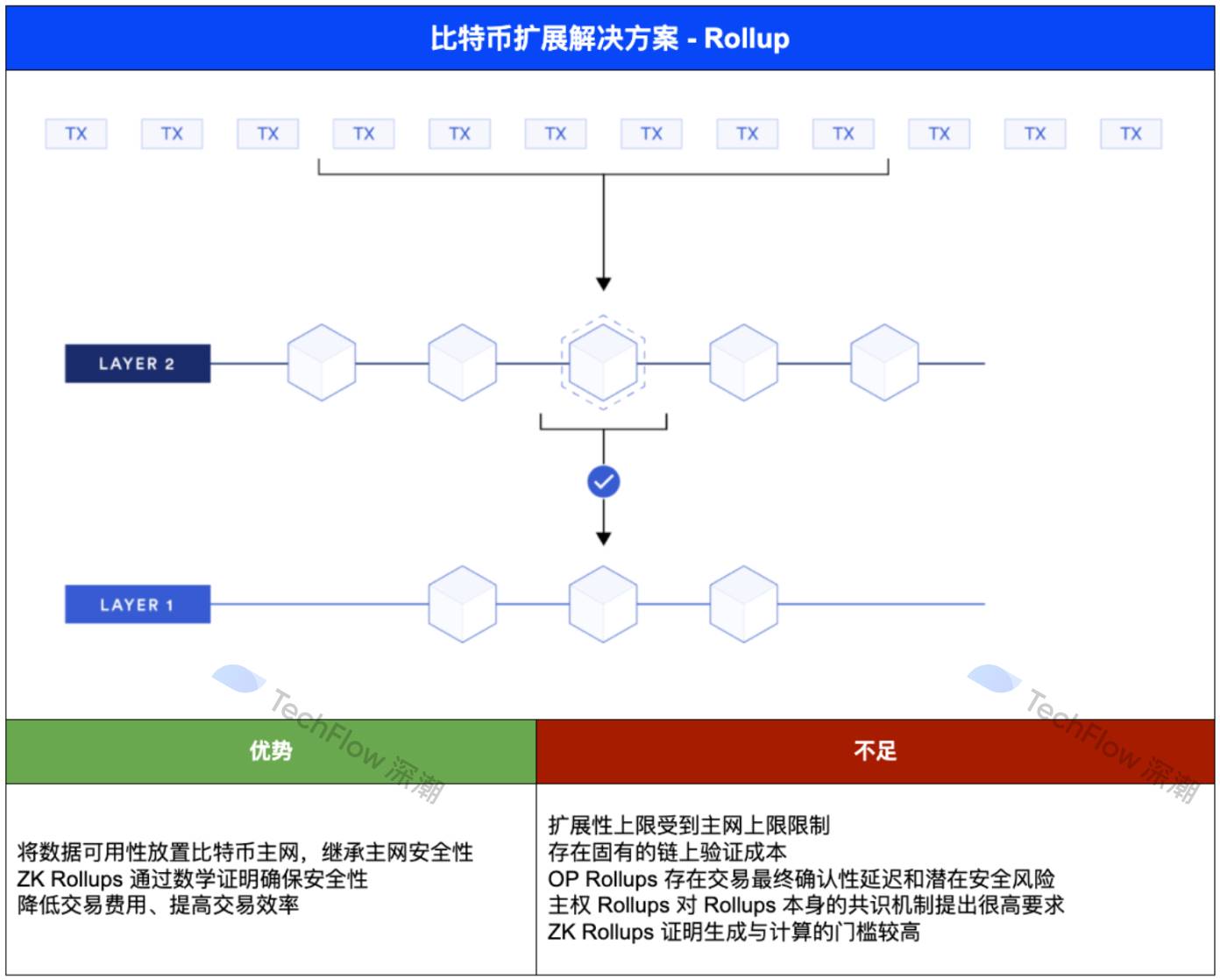
Source: Internet
While many view Rollups as an “imported” solution from Ethereum, the UTXO + Client-Side Validation approach feels more like a custom solution tailored to Bitcoin’s unique characteristics.
Explaining UTXO + Client-Side Validation requires some elaboration, partly due to its technical complexity and partly because of its multiple optimizations and evolutions over the past few years.
In Bitcoin, there is no concept of accounts; instead, it uses the UTXO (Unspent Transaction Output) model, which is central to Bitcoin transactions and forms the foundation of the UTXO + Client-Side Validation design path. Specifically, this approach attempts to calculate off-chain ledgers based on Bitcoin’s UTXO model, ensuring the authenticity of the ledger through client-side validation.
The idea originated in 2016 when Peter Todd introduced the concepts of Single-Use Seals and Client-Side Validation, which eventually led to the creation of the RGB protocol.
As the name suggests, a Single-Use Seal is like a digital seal that ensures a message can only be used once, while Client-Side Validation shifts the verification of token transfers from Bitcoin’s consensus layer to off-chain, with the validation performed by the clients involved in the specific transactions.
The core idea behind RGB is that users need to run their own clients and personally validate any asset changes relevant to them. Simply put, the recipient of the asset must first verify that the sender’s transfer statement is correct before the transfer becomes valid. This entire process happens off-chain, moving complex smart contract computations off-chain to achieve efficiency and privacy protection.
How does this approach inherit Bitcoin’s strong security? RGB uses Bitcoin’s UTXO as a “seal,” linking RGB state changes to the ownership of Bitcoin UTXOs. As long as the Bitcoin UTXO is not double-spent, the bound RGB assets cannot experience double-spending either, ensuring that Bitcoin’s robust security is preserved.
Certainly, the emergence of the RGB protocol holds great significance for the Bitcoin ecosystem. However, in its early stages, like many innovations, it remains rough around the edges, and several challenges persist:
For example, when regular users utilize simple client products, they often lack the capacity or resources to store the full history of transactions, making it difficult for them to provide proof of transactions to counterparties. Additionally, since different clients (or users) only store data relevant to themselves, they cannot see others’ asset statuses, which leads to the creation of data silos. This lack of global visibility and transparency severely hampers the development of DeFi and similar applications.
Another challenge lies in the fact that RGB transactions, as an extension of Bitcoin, rely on a separate P2P network for propagation. Interactive operations are also required between users during transfers, which again depend on this P2P network that is independent of the Bitcoin network.
More importantly, the virtual machine used by the RGB protocol, known as AluVM, lacks comprehensive developer tools and practical code implementations. Furthermore, RGB currently lacks a robust interaction framework for non-custodial (public) contracts, making multi-party interactions difficult to realize.
These issues have prompted long-standing, tech-savvy public blockchain projects like Nervos Network to explore more optimized solutions, leading to the development of RGB++.
Although RGB++ shares a name with RGB and originates from key concepts such as Single-Use Seals and Client-Side Validation, it is not a direct extension of RGB. In fact, RGB++ does not use any of RGB’s code. More precisely, RGB++ is a complete reimagining of RGB’s concepts, designed to implement a series of optimizations.
The core idea of RGB++ is to offload the data validation work previously handled by users, making it globally verifiable. Of course, users can still choose to run their own clients to validate RGB++ data and transactions.
Who is responsible for this validation? Public blockchains and platforms that support UTXO and extend its programmability, such as CKB and Cardano.
How is this achieved? This brings in the important concept of “homomorphic binding.” Bitcoin serves as the main chain, while CKB and Cardano act as shadow chains. The expanded UTXO on chains like CKB and Cardano serves as a container for RGB asset data, with RGB asset parameters written into these containers. This establishes a binding between the main chain and the shadow chains, allowing data to be directly displayed on the blockchain.
Using CKB as an example, due to the extended UTXO properties of its cells, CKB can establish a mapping relationship with Bitcoin UTXOs. This enables CKB to serve as a public database and an off-chain pre-settlement layer for RGB assets, replacing RGB clients and offering more reliable data custody and contract interactions for RGB.
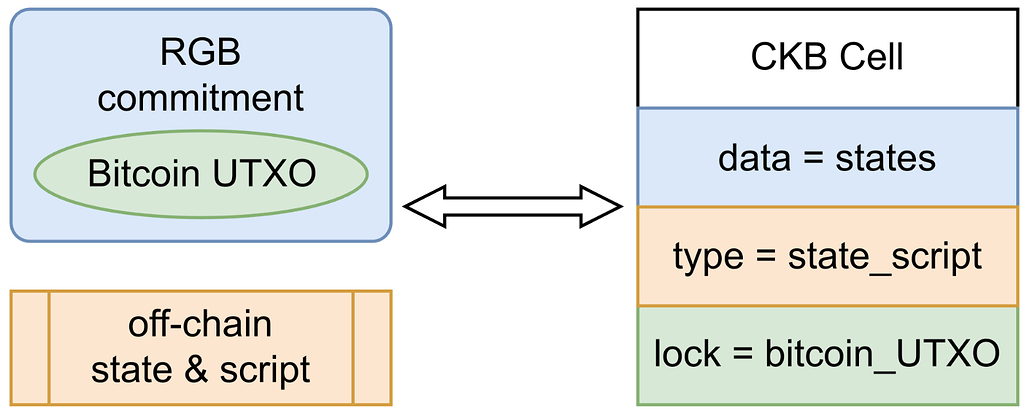
In this way, RGB++ not only inherits Bitcoin’s robust security foundation, but also introduces features such as non-interactive RGB transactions, the ability to aggregate multiple transaction commitments, and interaction between BTC assets and CKB chain assets without cross-chain operations. These advancements are expected to unlock a wider range of use cases, including DeFi.
The outstanding advantages in security, efficiency, and programmability have made RGB++ highly regarded in the industry since its inception, despite its high cognitive threshold. It has quickly become one of the most popular Bitcoin scaling protocols among mainstream adopters. With the completion of the upgrade to the RGB++ Layer in July 2024, Bitcoin scaling is once again at the forefront of innovation.
Even the name of this upgrade reveals much: the shift from “protocol” to “Layer” signifies that RGB++ is evolving towards broader service coverage, deeper aggregation, and more seamless interaction.
It’s like each country (blockchain) initially has its own set of operating rules, while RGB++ Layer aims to find a common ground (UXTO) to connect the key elements of ecological development. This facilitates a higher degree of “shared language and standardized practices,” laying a more robust foundation for scalable infrastructure in the Bitcoin ecosystem.
First and foremost, as an infrastructure, the RGB++ Layer must be easy to understand and widely accepted. It features a comprehensive native AA (Account Abstraction) solution, which is highly compatible with account standards from other blockchains. This not only supports critical use cases but also removes barriers to UX improvement.
The RGB++ Layer also strives to unify asset issuance. It supports the issuance of various RGB++ assets, including ERC20-like User-Defined Tokens (UDTs) and ERC721-like Digital Objects (DOBs). Thanks to the advantages of the UTXO model, the RGB++ Layer creates a new paradigm for asset issuance, allowing the same asset to be issued simultaneously across multiple chains in different proportions. This not only achieves coordination across different chains but also provides issuers with exceptional flexibility.
Since asset issuance can be unified, asset interaction becomes more seamless. Through RGB++ Layer’s cross-chain technology, Leap, assets on UTXO-based chains can move to another UTXO chain without the need for a cross-chain bridge. This brings stronger security and higher interoperability, enabling assets from UTXO chains like Cardano, Dogecoin, BSV, and BCH to integrate seamlessly into the Bitcoin ecosystem.
After solving the challenges of asset issuance and interaction, the RGB++ Layer aims to bring a unified smart contract framework and execution environment to the Bitcoin ecosystem via CKB-VM, giving Bitcoin enhanced programmability. Any programming language that supports the RISC-V virtual machine can be used for contract development on the RGB++ Layer, allowing for the creation of applications with complex logic. This opens the door for the growth of BTCFi and the realization of even more innovative use cases.
At this point, this article has covered the fundamental operating logic, representative projects, and pros and cons of four mainstream Bitcoin scaling protocols. Readers can review the content through the chart below for a clearer and more intuitive comparison of the advantages and disadvantages of each Bitcoin scaling protocol.
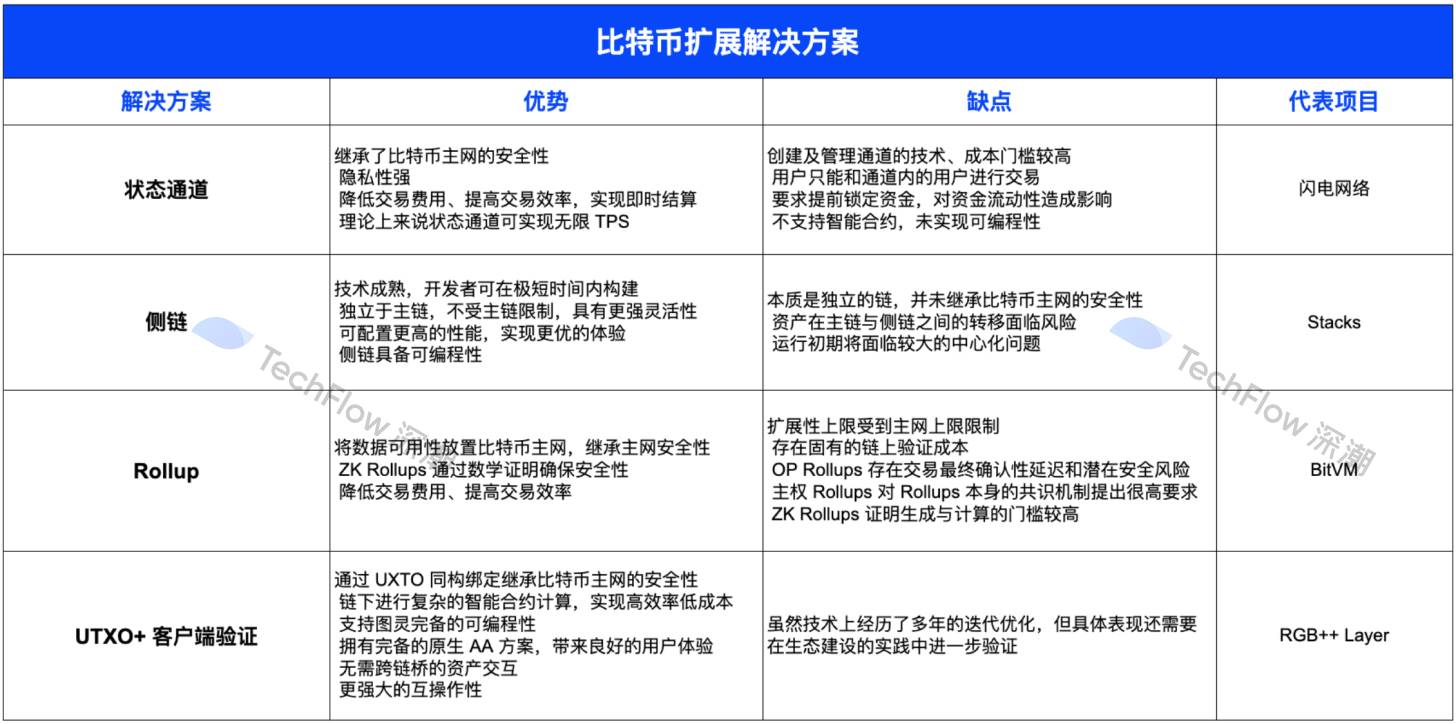
Certainly, the above content is a summary and reflection on the past performance of various solutions. In light of the Bitcoin ecosystem, which is poised for significant growth in this cycle, leading projects across various technical pathways are actively seeking innovation and breakthroughs to secure a more prominent position within the ecosystem.
Therefore, after comparing the past, we should shift our focus to the future by exploring the “rules of change” adopted by leading projects in different solutions, giving us a glimpse into the future competitive landscape of Bitcoin scaling solutions.
The legitimacy of the Lightning Network can be traced back to 2009 when Bitcoin’s founder, Satoshi Nakamoto, included a draft of payment channel code in Bitcoin 1.0—the prototype of the Lightning Network.
After more than a decade of development, the Lightning Network has reached a mature stage. According to 1ML, there are currently around 12,700 nodes, 48,300 payment channels, and approximately 5,212 BTC locked in the network. It has also established collaborations with multiple social and payment platforms.
Comparing these figures to those from May this year—13,600 nodes, 51,700 channels, and 4,856 BTC—we can see that the network’s growth in terms of capital has slowed, and the number of channels has even decreased. Additionally, in recent years, the community has voiced some negative opinions about the network.
On one hand, developers have been aware of the limitations and challenges in scalability since the early stages of Lightning Network’s development. The protocol is quite complex, making the development process both difficult and time-consuming.
On the other hand, despite years of growth, most people still perceive the Lightning Network as a payment solution. One of its core developers, Anton Kumaigorodski, candidly remarked on social media that beyond payments, people should look for other use cases. This statement further propelled the Lightning Network to a crossroads of transformation.
Adding to the challenges, internal disagreements seem to have plagued the project’s development. Over the past year, several developers have left the team, further hampering the already difficult development process.
However, the Lightning Network has not remained idle in the face of adversity. In addition to continuing to leverage its strengths and focusing on micropayments, the network has come to realize that the narrative of Bitcoin as a monetary network is more compelling than Bitcoin as just an asset. As a result, it has started moving towards building a multi-asset network.
On July 23, 2024, Lightning Labs released the first mainnet version of the multi-asset Lightning Network, officially integrating Taproot Assets into the network.
Before the Taproot Assets protocol, the Lightning Network only supported Bitcoin as a payment currency, severely limiting its use cases.
With the launch of the mainnet version of the multi-asset Lightning Network, anyone or any institution can now issue their own tokens using the Taproot Assets protocol. It also supports the issuance of fiat-backed stablecoins. Since assets issued through Taproot Assets are fully compatible with the Lightning Network, real-time global settlement of foreign exchange transactions, and stablecoin purchases for goods are now possible. This advancement is set to further position the Lightning Network as a foundational infrastructure for a global payment network.

In the Bitcoin ecosystem, Stacks stands out as a unique presence. Launched in 2017, it is considered an OG project and became the first token sale to receive approval from the U.S. Securities and Exchange Commission (SEC) under Regulation A+ in 2019.
According to data from DeFi 9 Llama, Stacks’ total value locked (TVL) has been on the rise since the start of 2024, fueled by the surge in interest in Bitcoin Ordinals (Inscriptions). In early April, Stacks’ TVL peaked at $183 million, but as the Ordinals craze subsided, its TVL has since dropped to around $100 million. Despite this decline, Stacks’ on-chain DeFi activity remains notable. For example, StackingDao, the leading liquid staking project on Stacks, has over 30,000 active staking users, and the number of unique wallets on the Stacks network has surpassed 1.21 million.
However, as a sidechain project, Stacks faces several challenges:
On one hand, the chain’s security is heavily dependent on the budget of Stacks miners. While the connection between the Stacks chain and the Bitcoin network (such as the Proof of Transfer mechanism) helps enhance decentralization and security, it also limits the chain’s performance and scalability.
On the other hand, although sidechains offer greater flexibility, Stacks essentially builds a new chain outside of the Bitcoin network, with its own governance structure and transaction model. This has led some to question its legitimacy, and it has not gained widespread recognition within the Bitcoin community.
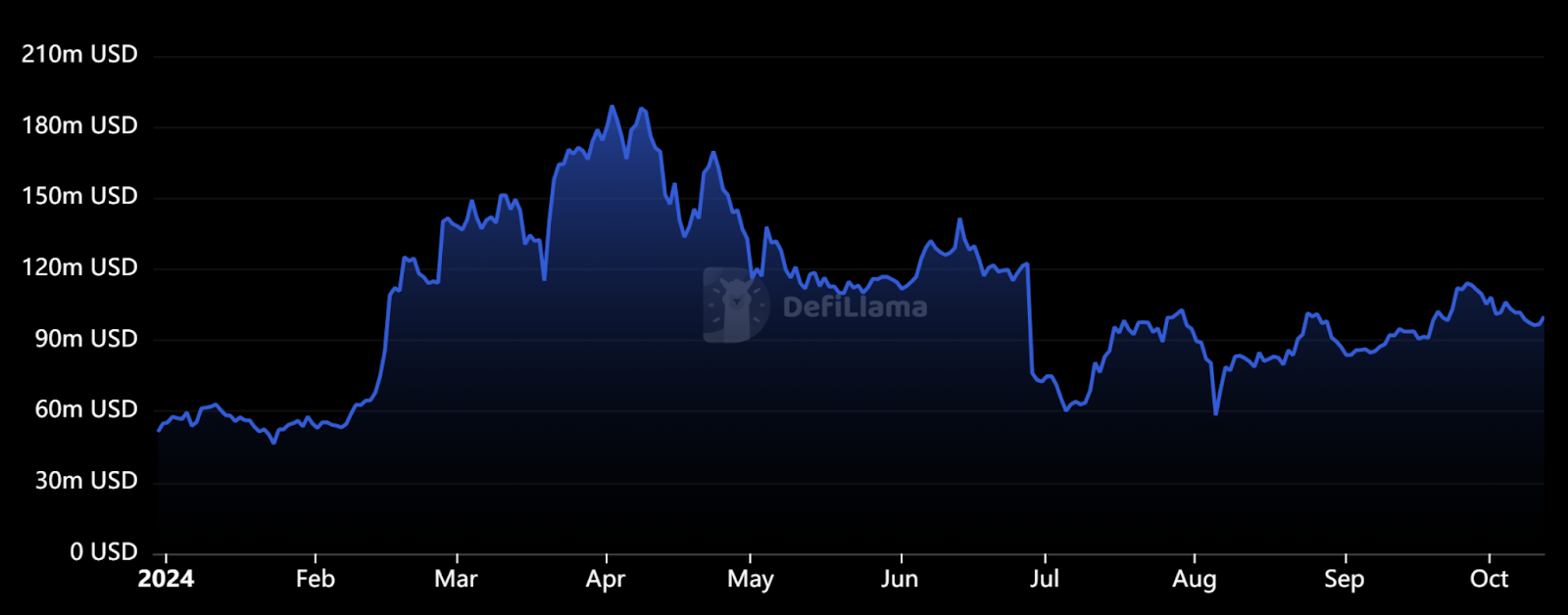
Recently, a milestone moment in the Stacks ecosystem is the Stacks Nakamoto upgrade. This upgrade not only enhances the security of Stacks but also significantly reduces block confirmation times, achieving transaction speeds of around 5-10 seconds—an increase of about 100 times compared to current speeds.
At the same time, the Stacks core team is also developing sBTC, a trustless solution for bridging BTC from the Bitcoin main layer to another chain. sBTC establishes a bridge for BTC assets between the Bitcoin network and the Stacks chain, with its permissionless and open participation features further unlocking DeFi innovations for Stacks and creating a $10 billion TVL opportunity.
As mentioned earlier, Bitcoin lacks a virtual machine, making it challenging to verify the validity of rollup proofs. BitVM aims to address this by introducing computation logic directly to Bitcoin without requiring any changes to Bitcoin itself. It enables off-chain computation while verifying any computation on the Bitcoin blockchain, thus opening the door for programmable features on Bitcoin, such as Turing-complete smart contracts.
Although BitVM is still in its early stages, it has already attracted attention from various projects and the community. Projects like Bitlayer, Citrea, Yona, and Bob have adopted BitVM for their solutions.
BitVM is also continually improving its mechanisms, with significant developments like the upcoming BitVM2 upgrade and the BitVM Bridge:
BitVM2 is designed to allow complex computations to be executed off-chain while proving fraud on-chain. This clever design enables Turing-complete computation verification within Bitcoin’s limited scripting capabilities.
BitVM Bridge introduces a new 1-of-n security model, where as long as one honest participant is involved, theft can be prevented. This innovation is seen as a major step forward for enhancing cross-chain security and decentralization, making it a catalyst for the growth of BTCFi.
It’s important to note, however, that while BitVM2 significantly simplifies the verification process, the on-chain verification gas costs remain relatively high. Additionally, BitVM is essentially a conceptual virtual machine that hasn’t fully materialized yet, and its operational logic hasn’t overcome the inherent limitations of ZK Rollups or Optimistic Rollups. As a result, many community members are still taking a cautious, wait-and-see approach to BitVM’s development.
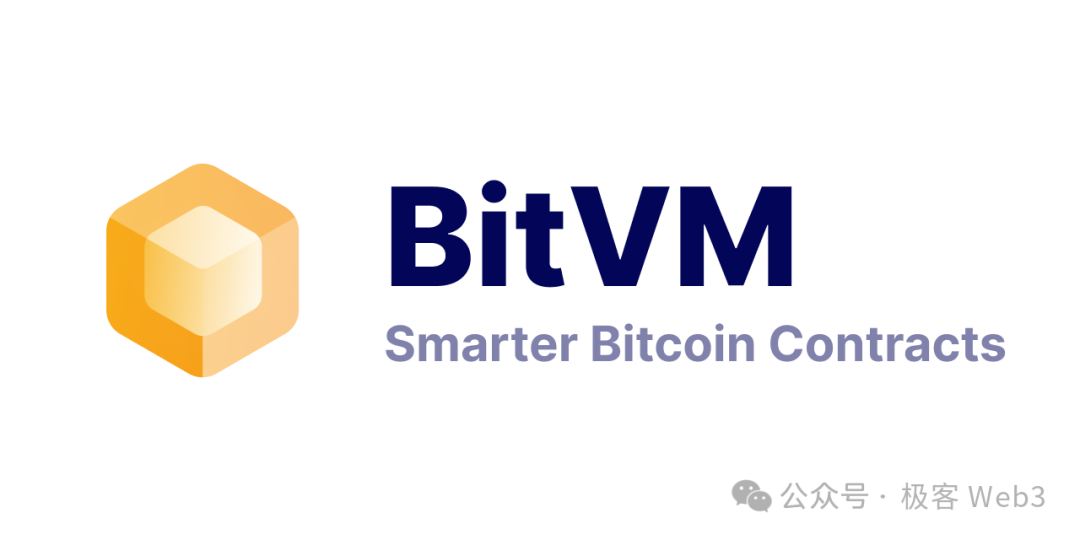
Following the completion of the RGB++ Layer upgrade, the focus shifted from brand narrative to more refined implementation pathways. The team chose to prioritize BTCFi, launching a series of technical iterations and ecosystem developments, and subsequently announced a range of important updates and innovative products aimed at integrating the Bitcoin asset issuance layer, smart contract layer, and interoperability layer. This initiative is propelling the development of a more secure, seamless, and efficient Bitcoin infrastructure.
In terms of asset issuance, the RGB++ Layer is introducing a new asset issuance model called IBO (Initial Bitcoin Offering). Its core feature allows for the creation of liquidity pools directly on UTXOSwap, enabling newly issued assets to be traded with high liquidity. This model balances fairness with community engagement, establishing a new paradigm for asset issuance in both the RGB++ ecosystem and the broader Bitcoin ecosystem.
As a decentralized exchange built on the RGB++ Layer, UTXOSwap utilizes intent-based trading as its core mechanism, implementing a process of off-chain matching and on-chain verification. By leveraging the parallelism of UTXOs, it aims to enhance transaction efficiency and become the central hub of the RGB++ Layer, aggregating liquidity from various UTXO chains and laying a solid foundation for DeFi development.
Recognizing the significance of stablecoins as a driving force in DeFi, the RGB++ Layer has also made early strategic moves in this area. Stable++ is a decentralized, over-collateralized stablecoin protocol capable of efficiently constructing over-collateralized vaults and liquidation modules, thanks to the robust Turing-complete programmability of the RGB++ Layer. It allows users to use BTC and CKB as collateral to mint the dollar-pegged stablecoin RUSD. Furthermore, due to the strong interoperability of the RGB++ Layer, RUSD is compatible with all UTXO chains and can circulate freely within the Bitcoin ecosystem, becoming a crucial component of BTCFi liquidity.
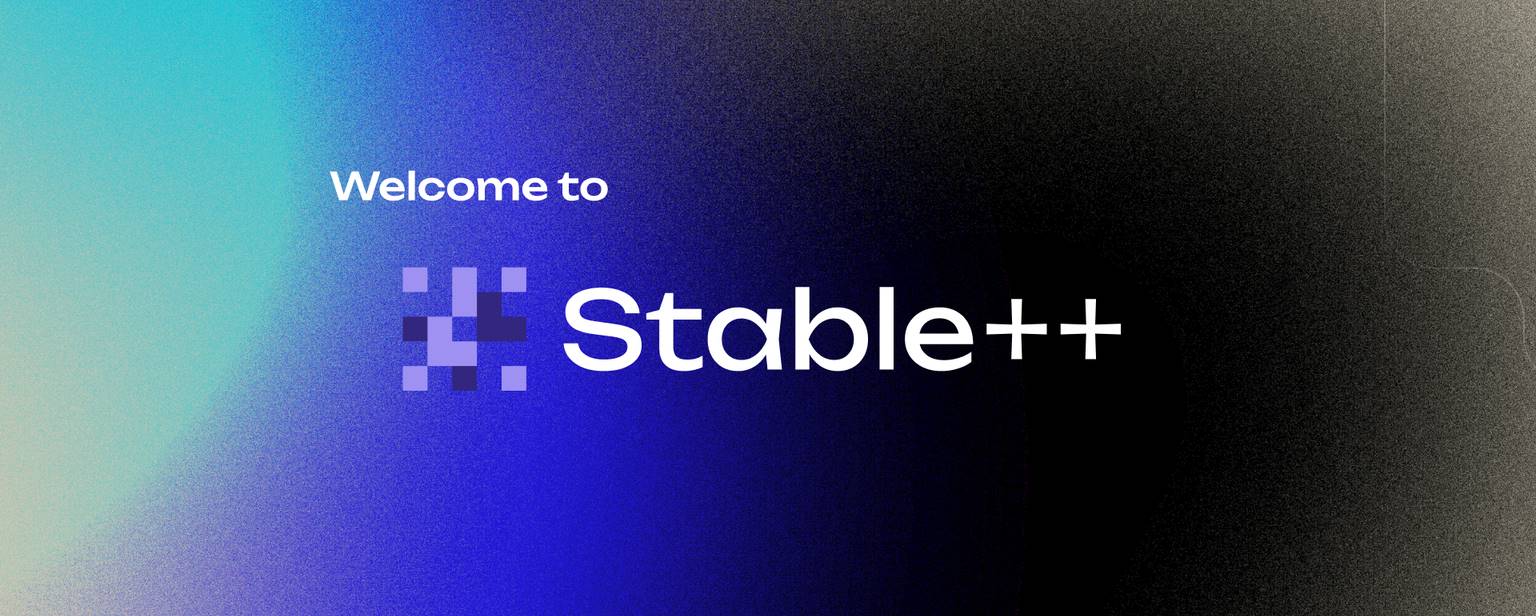
Beyond being an innovator, the RGB++ Layer is also committed to becoming an enabler for the Bitcoin ecosystem. It aims to further integrate liquidity and application scenarios through strategic partnerships, driving the next wave of growth in the Bitcoin ecosystem, with UTXO Stack and Fiber Network as prime examples.
In September, UTXO Stack announced its transformation into a staking layer for the Lightning Network, introducing a corresponding token incentive mechanism to encourage users to stake CKB and BTC to enhance the liquidity of state channels. These initiatives aim to provide better liquidity and yield models for the Lightning Network, paving the way for its widespread adoption.
Fiber Network, on the other hand, is an L2 network based on CKB, with initial functionalities similar to the Lightning Network. It aims to become a high-performance, low-cost payment network for microtransactions. However, compared to the Lightning Network, Fiber Network benefits from the Turing-completeness of CKB, offering greater flexibility in liquidity management, higher efficiency, lower costs, and an improved user experience. Notably, while the Lightning Network focuses solely on BTC, Fiber Network supports multiple assets, including BTC, CKB, and the Bitcoin-native stablecoin RUSD, as well as other RGB++ assets, paving the way for complex cross-chain financial applications.
Importantly, the emergence of Fiber Network is not intended to replace the Lightning Network. Its ultimate goal is to serve as a scalability solution for programmability within the Bitcoin ecosystem. Throughout this process, Fiber Network will closely collaborate with the Lightning Network. Its technical stack primarily includes CKB’s Cells, the RGB++ Layer, Bitcoin script’s HTLC, and the Lightning Network’s state channels. The first test version of Fiber Network has already validated the feasibility of transferring assets from the BTC Lightning Network to CKB in a decentralized manner, enabling more BTC assets to circulate on CKB.
Due to the technical isomorphism between Fiber Network and the Lightning Network, there is a natural foundation for achieving cross-chain atomic swaps. This combination of “Bitcoin-level security + Ethereum-level functionality + Lightning Network-level speed” will not only shine in the payments space but also facilitate the realization of DeFi applications like native stablecoins, native lending, and native DEXs within the Bitcoin ecosystem, further propelling the explosion of BTCFi.
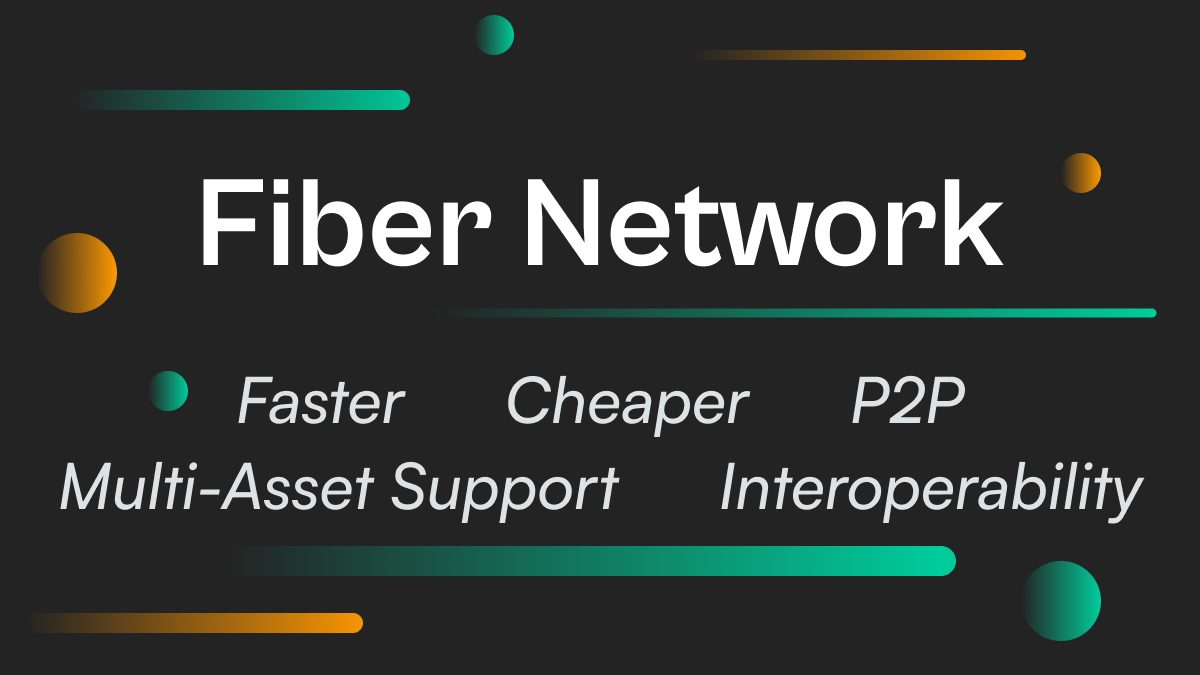
Through this article, we’ve explored the diverse landscape of Bitcoin scaling solutions:
State channels theoretically enable infinite TPS.
Sidechains offer significant flexibility advantages.
The success of Rollups within the Ethereum ecosystem has raised expectations for their development in the Bitcoin ecosystem.
The UTXO + client verification approach has gone through several iterations, with the RGB++ Layer emerging as a comprehensive solution. It not only inherits the security of the Bitcoin mainnet but also offers numerous advantages in user experience, programmability, and interoperability, making it a technically advanced and well-rounded Bitcoin scaling solution.
However, it’s worth noting that while the RGB++ Layer has been continuously refined and optimized with a clear development trajectory, its actual performance still requires further validation through real-world ecosystem building. As various projects within the ecosystem implement their roadmaps and launch products, the key question remains: will the RGB++ Layer become a major force in unlocking BTCFi’s potential?
The competition in Bitcoin scaling solutions is still in full swing, with each proposal highlighting its unique strengths. Ultimately, the community is eagerly watching to see which solution will come out on top.
Recommendation

When 9 of the Top 100 Market Caps Are Memes, Embracing Attention Investing Is Clearly the Way Forward
Jul 07, 2024 14:12

Interpreting Everclear: The First Chain Abstraction Clearing Layer to Address Cross-Chain Liquidity Fragmentation through Net Settlement
Jun 06, 2024 21:56
NAVI
NAVIs Rise in Sui Ecosystem: Building on Lending + LST Success, Ready to Scale as Native USDC Launch
Nov 11, 2024 15:34